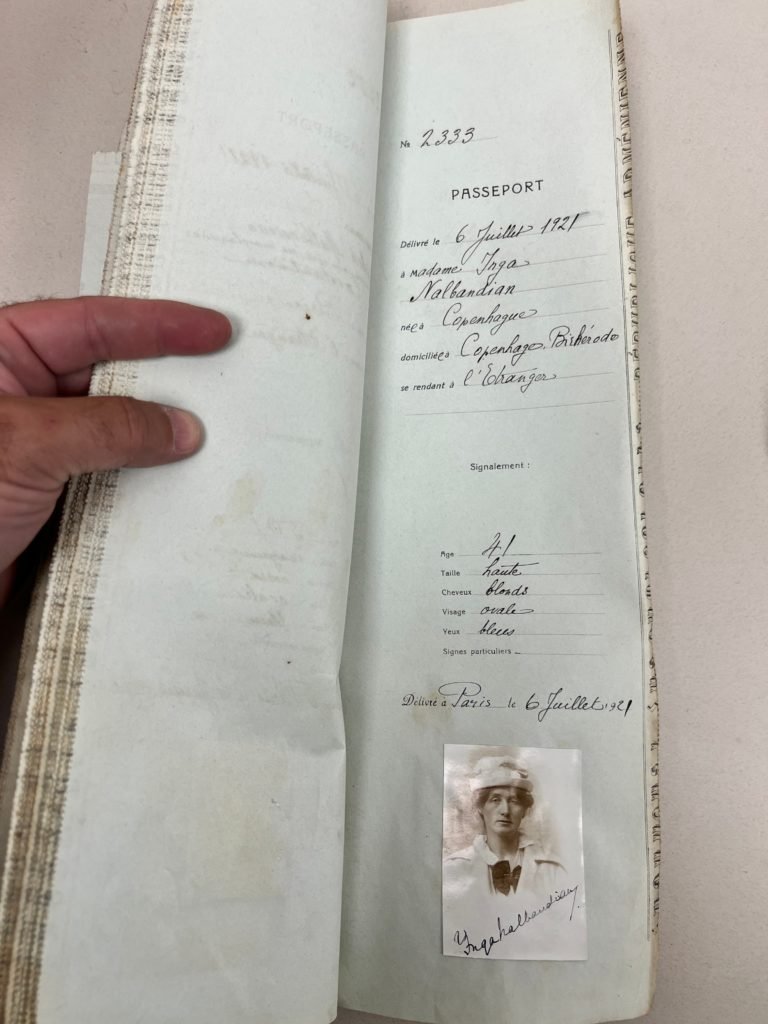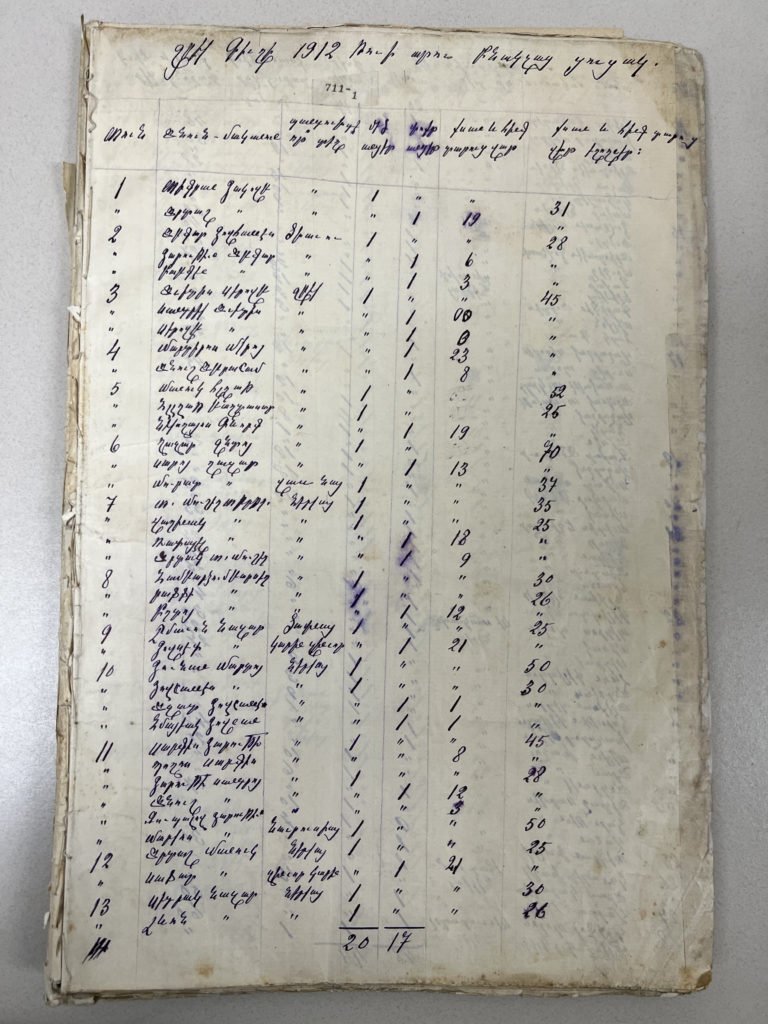Krikor (George) Nahabedian was born in the village of Parchanj (Kharpert region) around 1884. He married Khachkatoun Garabedian, and soon thereafter, a son Boghos was born. Krikor arrived in the US in 1912 on the SS Majestic, leaving behind his wife and son. It would be over 10 years before he would see them again.
The book Village of Parchanj: General History by Manoog Dzeron includes family trees for around 100 families including the Nahabedians (Chaghchban Navo) and Garabedians (Kharachortsi Garabedenk). Khachkatoun’s family was said to have come to Parchanj from Aghmezre sometime prior to the Hamidian massacres, and I was able to confirm this through Ottoman population registers. From these records, we can trace Khachkatoun’s family back to Ohanes, son of Mateos, born around 1780.

What is fascinating is that the archives of the Armenian Revolutionary Federation (ARF) contain the passport application of Boghos Nahabedian. Boghos signed his passport application on July 31, 1923. Coincidentally, he would arrive in the US in 1925 on the very same SS Majestic as his father did more than a decade before. The family settled in the New England area, and their descendants remain part of the local Armenian community.

Over the past year, significant progress has been made in digitizing portions of the ARF archives to make them better accessible to the public. In particular, thousands of photographs have been scanned and will gradually be made available through a revamped website. This collection ranges from photographs of early fedayees, portraits of leading individuals and ARF organizational bodies, as well as images with cultural, religious and ethnographic themes.
The photographs will be of interest to historians and the general Armenian public, particularly to many whose family members appear in them.
But photographs are not the only items within the archives that will capture the interest of every Armenian.
In late summer, while unpacking each and every box in the archives—including some that had not been opened in more than 30 years—I came across the records of approximately 20,000 passport applications submitted to the government in exile of the Republic of Armenia after its fall in 1920. Included in the 20,000 was the application of Boghos Nahabedian.
My excitement at finding such a significant treasure trove was heightened by the knowledge that my grandmother Margaret DerManouelian had carried one of these passports issued in the name of the Republic of Armenia and dated 1928 when she arrived in the United States.
Armenians had become a stateless people and could not travel internationally. Countries would not accept travelers who did not possess citizenship of another country, for they would be unable to deport them when necessary. After World War I, hundreds of thousands of refugees had been trapped, including most Armenians. These passports issued by the Armenian government in exile allowed for travel. It was not until 1924 that Armenians would be covered by the more well-known Nansen passports.
Each application includes a photograph of the person, their birthplace and date of birth, the name of their father and maiden name of their mother. Also included is the location where the person was living at the time. It very well could be that these documents will constitute the only place to locate such information for thousands of Armenians.
When the passports were issued, they were ripped from a ledger along a perforation that left a stub receipt. This receipt also contained a photograph and the name of the person for whom the passport was being issued. The ARF archives also contains a number of these receipts.

One receipt in particular caught my eye. It was for someone born in Copenhagen around 1880. At first, I was amazed to think Armenians had been living in Copenhagen long enough to have children born there and to give them a Scandinavian first name of Inga. However, a bit of research showed that Inga Nalbandian was the married name for Inga Henriette Lucinde Collins. Inga had met and married Paul Mardiros Nalbandian in Switzerland before settling in Constantinople. After her husband’s death, she returned to Denmark and wrote three books with Armenian themes. The books have been translated into English and published together under the title Your Brother’s Blood Cries Out. It is fascinating to learn that on July 6, 1921 she received a passport from the Republic of Armenia!
The archives also contain some canceled and unused passports. But there are other treasures in the archives that will be of broad interest. For example, thus far there have never been any detailed records, census, sacraments or otherwise, that have ever come to light for the region of Moush. The Ottoman archives in Istanbul only contain summary registers for the Bitlis region. Similarly, Armenian church records are only available in summation. However, recently a census performed by the ARF in 1912 was found in the archives for 17 villages of the Moush plain. The names of 5,420 Armenian males in 1,662 households are given in these 17 villages. It seems clear that the register was originally much larger, but it is fortunate that even this much has remained.

Since its founding in 1890, the ARF has both guided and reflected the aspirations of the Armenian people and the trauma they have experienced. Thus, a study of the history of the party is also a study of the Armenian nation over the past 130-plus years. You cannot understand one without the other.
Before the first decade of existence, the ARF understood the need to preserve a record of the work of the party and Rosdom (Stepan Zorian) is the person to thank for that. But it was in the 1930s and 1940s that the real work of organizing the archives of the ARF took place, and this important responsibility fell on the shoulders of Apraham Giulkhandanian.
While significant work has been accomplished thus far, there is much more yet to do. Those wishing to make a tax-deductible donation toward the work of digitizing the archives and making them available online can do so here.


Amazing document you found in the ARF archives !
Thank you, George! One never knows where information may come from when working on family history and you may have hit on some connections for me. I notice on the naturalization application it is signed by a Thomas Mingain from Providence, RI. Certainly, an unusual last name. I only know it tough because the Mingain’s were close to my grandparents and often they were called cousins and the families frequently visited each other. Thomas may be Takvor Mingain from Bursa and I remember him and am still in contact with his grandson and will forward your article. And if Boghos Nahabedian is Paul Nahabedian of Watertown, he was an Unger in the Gomideh. I photographed him for an article in the Weekly or for an oral history interview. I found a quote that might be appropriate here: “Human connections are deeply nurtured in the field of shared story” by Jean Houston.
I have a good photo of one of our fighters maybe from Van. To whom might I send it ? Then I have a bigger part of a tile which might be from Surb Pavlos-Bedros Jegeretsi in Van. To whom could I send this
?
You can send them to my attention to the Hairenik Building – 80 Bigelow Avenue, Watertown MA
Wonderful finds! I can’t wait to see what else you dig up. Wish I was closer to be able to help.